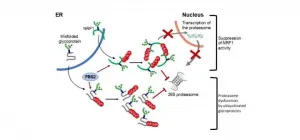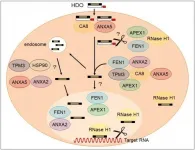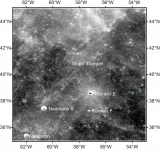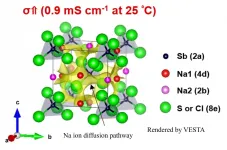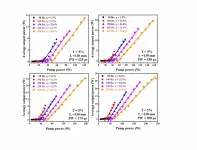(Press-News.org) The urgency to remember a dangerous experience requires the brain to make a series of potentially dangerous moves: Neurons and other brain cells snap open their DNA in numerous locations--more than previously realized, according to a new study--to provide quick access to genetic instructions for the mechanisms of memory storage.
The extent of these DNA double-strand breaks (DSBs) in multiple key brain regions is surprising and concerning, said study senior author Li-Huei Tsai, Picower Professor of Neuroscience at MIT and director of The Picower Institute for Learning and Memory, because while the breaks are routinely repaired, that process may become more flawed and fragile with age. Tsai's lab has shown that lingering DSBs are associated with neurodegeneration and cognitive decline and that repair mechanisms can falter.
"We wanted to understand exactly how widespread and extensive this natural activity is in the brain upon memory formation because that can give us insight into how genomic instability could undermine brain health down the road," said Tsai, who is also a professor in the Department of Brain and Cognitive Sciences and a leader of MIT's Aging Brain Initiative. "Clearly memory formation is an urgent priority for healthy brain function but these new results showing that several types of brain cells break their DNA in so many places to quickly express genes is still striking."
Tracking breaks
In 2015, Tsai's lab provided the first demonstration that neuronal activity caused DSBs and that they induced rapid gene expression. But those findings, mostly made in lab preparations of neurons, did not capture the full extent of the activity in the context of memory formation in a behaving animal and did not investigate what happened in cells other than neurons.
In the new study published July 1 in PLOS ONE, lead author and former graduate student Ryan Stott and co-author and former research technician Oleg Kritsky sought to investigate the full landscape of DSB activity in learning and memory. To do so, they gave mice little electrical zaps to the feet when they entered a box, to condition a fear memory of that context. They then used several methods to assess DSBs and gene expression in the brains of the mice over the next half hour, particularly among a variety of cell types in the prefrontal cortex and hippocampus, two regions essential for the formation and storage of conditioned fear memories. They also made measurements in the brains of mice who did not experience the foot shock to establish a baseline of activity for comparison.
The creation of a fear memory doubled the number of DSBs among neurons in the hippocampus and the prefrontal cortex, affecting more than 300 genes in each region. Among 206 affected genes common to both regions, the researchers then looked at what those genes do. Many were associated with the function of the connections neurons make with each other, called synapses. This makes sense because learning arises when neurons change their connections (a phenomenon called "synaptic plasticity") and memories are formed when groups of neurons connect together into ensembles called engrams.
"Many genes essential for neuronal function and memory formation, and significantly more of them than expected based on previous observations in cultured neurons...are potentially hotspots of DSB formation," the authors wrote in the study.
In another analysis, the researchers confirmed through measurements of RNA that the increase in DSBs indeed correlated closely with increased transcription and expression of affected genes, including ones affecting synapse function, as quickly as 10-30 minutes after the foot shock exposure.
"Overall, we find transcriptional changes are more strongly associated with [DSBs] in the brain than anticipated," they wrote. "Previously we observed 20 gene-associated [DSB] loci following stimulation of cultured neurons, while in the hippocampus and prefrontal cortex we see more than 100-150 gene associated [DSB] loci that are transcriptionally induced."
Snapping with stress
In the analysis of gene expression, the neuroscientists looked at not only neurons but also non-neuronal brain cells, or glia, and found that they also showed changes in expression of hundreds of genes after fear conditioning. Glia called astrocytes are known to be involved in fear learning, for instance, and they showed significant DSB and gene expression changes after fear conditioning.
Among the most important functions of genes associated with fear conditioning-related DSBs in glia was the response to hormones. The researchers therefore looked to see which hormones might be particularly involved and discovered that it was glutocortocoids, which are secreted in response to stress. Sure enough, the study data showed that in glia, many of the DSBs that occurred following fear conditioning occurred at genomic sites related to glutocortocoid receptors. Further tests revealed that directly stimulating those hormone receptors could trigger the same DSBs that fear conditioning did and that blocking the receptors could prevent transcription of key genes after fear conditioning.
Tsai said the finding that glia are so deeply involved in establishing memories from fear conditioning is an important surprise of the new study.
"The ability of glia to mount a robust transcriptional response to glutocorticoids suggest that glia may have a much larger role to play in the response to stress and its impact on the brain during learning than previously appreciated," she and her co-authors wrote.
Damage and danger?
More research will have to be done to prove that the DSBs required for forming and storing fear memories are a threat to later brain health, but the new study only adds to evidence that it may be the case, the authors said.
"Overall we have identified sites of DSBs at genes important for neuronal and glial functions, suggesting that impaired DNA repair of these recurrent DNA breaks which are generated as part of brain activity could result in genomic instability that contribute to aging and disease in the brain," they wrote.
INFORMATION:
The National Institutes of Health, The Glenn Foundation for Medical Research and the JPB Foundation provided funding for the research.
Peptide: N-glycanase (NGLY1) is an evolutionarily conserved enzyme for removing N-linked glycans (N-glycans) from glycoproteins and is involved in proteostasis of N-glycoproteins in the cytosol. In 2012, a rare genetic disorder called NGLY1 deficiency was discovered by an exome analysis. Symptoms in patients with NGLY1 deficiency include global developmental delay, hypotonia, hypo/alacrima, movement disorder, scoliosis, abnormal liver, brain functions and peripheral neuropathy. Unfortunately, no therapeutic treatment is currently available to this devastating ...
Researchers from Tokyo Medical and Dental University (TMDU) find proteins that bind to and regulate tocopherol-conjugated heteroduplex oligonucleotides during gene silencing
Tokyo, Japan - Gene silencing therapies are used to interfere with, or "silence", the expression of genes that are associated with disorders. Now, a team at TMDU has uncovered some of the cellular mechanisms by which the silencing therapies act in cells.
Antisense oligonucleotide (ASO) therapies use small strands of DNA or RNA that are antisense, or complementary, to the associated gene to interfere with its expression. ASO therapies are already available for some diseases, particularly neurological disorders, but their use is at a very ...
China's lunar exploration project can be divided into three steps: "orbiting", "landing" and "returning". At present, the first two have been completed, and the third step, "return", will be achieved by the CE-5, which is the first sample return satellite of China and is expected to drill at a depth of no less than 2 m and bring back about 2 kg of scientific samples. In June 2017, the landing region of CE-5 lunar probe was selected as the Rümker region, which is located in the northern Oceanus Procellarum on the lunar near side and has a long volcanic history and complex geological composition.
Because the geographical scope of the region is not clearly defined, the extent determined by the researchers is 35°-45°N ...
The change from early years services into formal educational settings has long been considered an integral transition point for young people. Now research from Flinders University now asks, "Is service integration actually important to the children?"
A recent paper, published in Children's Geographies, led by Flinders University PhD Dr Jennifer Fane, who is now based at Capilano University in Canada, actually seems to have little impact on children's experiences of this transition.
The Australian Government has supported the Integrated Early Years Services since 2005, following what is considered best practice policy for supporting children and families. It is considered to constitute services that are connected ...
Tantalising evidence has been uncovered for a mysterious population of "free-floating" planets, planets that may be alone in deep space, unbound to any host star. The results include four new discoveries that are consistent with planets of similar masses to Earth, published today in Monthly Notices of the Royal Astronomical Society.
The study, led by Iain McDonald of the University of Manchester, UK, (now based at the Open University, UK) used data obtained in 2016 during the K2 mission phase of NASA's Kepler Space Telescope. During this two-month campaign, Kepler monitored a crowded field of millions ...
Hannah Enders and Dr. Florian Hennicke describe the precise anatomy of these structures of the poplar mushroom in the Journal of Fungi of 19 May 2021.
An edible wild mushroom
One of the organisms attacked by the fungus Cyclocybe parasitica is the Tawa tree (Beilschmiedia tawa), which is relevant to the timber industry in New Zealand. Cyclocybe parasitica is widespread in the Pacific region and has long been known to the Maori, the indigenous people of New Zealand, under the name "Tawaka" as an edible wild mushroom.
Biology student Hannah Elders, supervised by Florian Hennicke at ...
A research collaboration based in Kumamoto University, Japan has discovered that muscles and the resident stem cells (satellite cells) responsible for muscle regeneration retain memory of their location in the body. This positional memory was found to be based on the expression pattern of the homeobox (Hox) gene cluster, which is responsible for shaping the body during fetal life. These findings are expected to provide clues to elucidate the pathogenesis of muscle diseases such as muscular dystrophy, in which the position of muscle vulnerability varies depending on the type of muscle, and to help develop regenerative ...
Overview:
A research team from the Department of Electrical and Electronic Information Engineering at Toyohashi University of Technology developed a chlorine (Cl) substituted Na3SbS4 solid electrolyte for use in all-solid-state sodium (Na) ion batteries. Compared to the sample without a Cl substitution, the ionic conductivity of the Na3SbS4 solid electrolyte where sulfur (S) was partially substituted with Cl improved by up to three times. The team also demonstrated that the Cl-substituted Na3SbS4 has a crystal structure framework that allows Na ions to move easier ...
The Mid-infrared lasers (MIR) with high peak power and high repetition rate operating in the range of 2.7~3 μm have important application in laser surgery and optical parametric oscillator (OPO).
A recent study conducted by SUN Dunlu's research group at the Hefei Institutes of Physical Science(HFIPS) of the Chinese Academy of Sciences (CAS) achieved high power, high efficiency and quasi-continuous mid-infrared laser in the free running and langasite [La3 Ga5 SiO14 (LGS)] Q-switched modes by using the Er3+ ions-doped YAP crystals as laser gain medium.
Based on their previous research work on laser, the researchers further improved the laser performance of Er:YAP laser crystal by laser-diode (LD) side-pumping method, a Er:YAP crystal ...
Sleep problems are common in the general population with up to half of Singaporean adults reporting insufficient or unsatisfying sleep. Sleep quality tends to worsen with age and poor sleep is a modifiable risk factor for multiple disorders, including cardiovascular disease and cognitive impairment.
Currently, insomnia is treated with either medication or psychological interventions. However, even frontline treatments such as cognitive-behavioural therapy have limitations - up to 40% of patients do not get relief from their insomnia symptoms after undergoing ...

